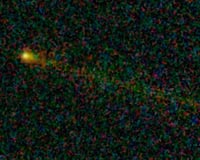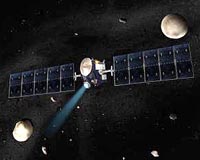|
 Small Asteroid To Pass Within Earth-Moon System Tuesday
Small Asteroid To Pass Within Earth-Moon System TuesdayPasadena CA (JPL) Oct 12, 2010 A small asteroid will fly past Earth early Tuesday within the Earth-moon system. The asteroid, 2010 TD54, will have its closest approach to Earth's surface at an altitude of about 45,000 kilometers (27,960 miles) at 6:50 EDT a.m. (3:50 a.m. PDT). At that time, the asteroid will be over southeastern Asia in the vicinity of Singapore. During its flyby, Asteroid 2010 TD54 has zero probability of impacting Earth. A telescope of the NASA-sponsored Catalina Sky Survey north of Tucson, Arizona discovered ... read more |
. |
|
|
Free Space, Earth, Energy And Military Newsletters - Delivered Daily |
| . | . |
| .. |
VISTA Reveals Secret Of Unicorn Paris, France (ESA) Oct 07, 2010
Paris, France (ESA) Oct 07, 2010A new infrared image from ESO's VISTA survey telescope reveals an extraordinary landscape of glowing tendrils of gas, dark clouds and young stars within the constellation of Monoceros (the Unicorn). This star-forming region, known as Monoceros R2, is embedded within a huge dark cloud. The region is almost completely obscured by interstellar dust when viewed in visible light, but is spectac ... more Saturn's Icy Moon May Keep Oceans Liquid With Wobble  Pasadena CA (JPL) Oct 07, 2010
Pasadena CA (JPL) Oct 07, 2010Saturn's icy moon Enceladus should not be one of the most promising places in our solar system to look for extraterrestrial life. Instead, it should have frozen solid billions of years ago. Located in the frigid outer solar system, it's too far from the sun to have oceans of liquid water - a necessary ingredient for known forms of life - on its surface. Some worlds, like Mars or Jupiter's ... more Japan space probe may have brought home space dust: reports  Tokyo (AFP) Oct 6, 2010
Tokyo (AFP) Oct 6, 2010Japan's space agency has found particles that may be extra-terrestrial in the capsule of the space probe Hayabusa that returned home in June after a seven-year journey to an asteroid, reports said Wednesday. Scientists discovered minute particles that may be from outside Earth, the Yomiuri newspaper and Kyodo News agency reported. Their components have characteristics that differ from du ... more |
.. |
 WISE Captures Key Images Of Comet Mission Destination  Orbital Environment For Dawn Spacecraft At Vesta  Instant online solar energy quotes Solar Energy Solutions from ABC Solar |
.. |
|
|
Free Space, Earth, Energy And Military Newsletters - Delivered Daily |
|
|
. |
 Pushing The Envelope Leaves A Blast Of Relativistic Particles
Pushing The Envelope Leaves A Blast Of Relativistic ParticlesHuntsville AL (SPX) Oct 06, 2010 G327.1-1.1 is the aftermath of a massive star that exploded as a supernova in the Milky Way galaxy. A highly magnetic, rapidly spinning neutron star called a pulsar was left behind after the explosion and is producing a wind of relativistic particles, seen in X-rays by Chandra and XMM-Newton (blue) as well as in the radio data (red and yellow). This structure is called a pulsar wind nebula. The likely location of the spinning neutron star is shown in the labeled version. The large red circle shows ... read more |
| The contents herein, unless otherwise known to be public domain, are Copyright 1995-2010 - SpaceDaily. AFP and UPI Wire Stories are copyright Agence France-Presse and United Press International. ESA Portal Reports are copyright European Space Agency. All NASA sourced material is public domain. Additional copyrights may apply in whole or part to other bona fide parties. Advertising does not imply endorsement, agreement or approval of any opinions, statements or information provided by SpaceDaily on any web page published or hosted by SpaceDaily. Privacy statement |
| Previous Issues | Oct 11 | Oct 08 | Oct 07 | Oct 06 | Oct 05 |